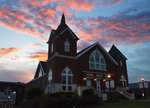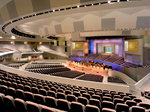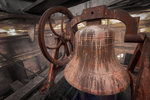









Editor’s note: This is one of a series of articles commemorating the 200th anniversary of the Georgia Baptist Convention, which will hold an annual meeting Nov. 13-15 at Warren Baptist Church in Augusta.
DALLAS, Ga. – Crude hand-hewn log church buildings have given way to massive contemporary structures. Hitching posts are long gone, replaced by paved parking lots. Pot-bellied stoves disappeared with the advent of central heat and air.
Churches have undergone major transformations since the founding of the Georgia Baptist Convention 200 years ago.
“The changes are dramatic,” said Charles Jones, a church historian and longtime pastor from Athens. “Those in 1822 could never have fathomed what houses of worship would look like today.”
Kiokee Baptist Church, whose founding predates the GBC by 50 years, is the oldest Baptist church in Georgia. When it was founded, construction methods were primitive in comparison to today’s modern techniques.
Jones explains that building a meeting house 250 years ago meant backbreaking work. Trees needed to be cut down and logs shaped by hand to build what was typically a simple, one-room meeting house. Often, early churches met in mills, schools, and barns. Even when congregations had a dedicated building, they weren’t often called churches, but instead simply “meeting houses,” says Jones.
Many of the earlier buildings, especially those constructed prior to the 1920s, had two front doors. Jones says that’s because men and women would sit separately on different sides of the building.
Security concerns were also factored into the design and construction of some church buildings. For example, Bethesda Baptist Church, a sturdy brick building in Union Point built in 1815, was intended to keep adversaries out. “Nearby Greensboro had been attacked and burned by Indians a few years before, so the new structure was built like a fortress, with walls five courses of bricks thick on the lower level and cleared fields with good visibility in the event of unrest, with lookouts posted on the second floor,” Jones said.
Because of the possibility of attacks, early laws mandated that men bring weapons to church, as it was not thought wise to have large gatherings of unarmed citizens, so many churches had gun racks by the doors.
As the population of Georgia has grown, so has the membership of some of the state’s largest churches. Churches require larger facilities to accommodate those numbers.
In the years since its founding, Kiokee Baptist Church members have met in seven different buildings, the latest completed in 1995.
Many Georgia churches today encompass multi-acre campuses consisting of multiple large buildings. Some churches have separate buildings for classes and worship, and some even boast gymnasiums in addition to their sanctuaries.
Midway Church in Villa Rica started out in 1847 as a simple log cabin for 11 charter members. Over the years, Midway has grown exponentially, and so have its facilities. The church now sits on a 100-acre, $15 million campus, and has more than 3,000 members. In 1842, 15 charter members gathered to found Hebron Baptist Church in Dacula. Today, members meet in a worship center that seats 3,600 attendees.
Changes in transportation over the centuries have also necessitated changes to church properties. The advent of the automobile, says Jones, paved the way for worshippers to travel further to get to church. No longer were they tied to attending the closest church. A trek that what would have taken hours 200 years ago can be completed in mere minutes today. As churches began to accommodate more drivers, parking lots naturally expanded as well.
Early churches often did not have steeples, but after the Civil War, as people relocated to more urban areas and construction methods changed, they became ubiquitous. Steeples at that time graced many churches in the state – their elevated crosses marking the church as a prominent part of its community. Those steeples clearly identified places of worship, creating recognizable landmarks, and housed bells that were used to call the church to worship.
Nowadays, many congregations are eliminating steeples altogether, in part because of simple economics. A 2011 article in U.S. News & World Report looked at that trend, finding that the high cost to build and maintain steeples has meant their elimination from many landscapes. For others, it is a question of function. As church needs change, so does the design of the buildings, and some consider steeples to no longer be necessary to identify the building as a house of worship.
Yet another area that has seen great changes is the baptistry. Where once most churches held outdoor baptism as a matter of necessity, in the past 100 years the majority of churches have moved their baptisms indoors, with a baptistry on the stage or behind the altar of their worship centers.
Others, like Cascade Hills Baptist Church, have returned to outdoor baptisms. The church, which on average has baptized someone every day since 2015, has built a stunningly beautiful outdoor baptismal pool, complete with waterfalls. Because it is heated, the pool can be, and is, used even in the winter months.
Looking forward, all we can be sure of is that church facilities will no doubt continue to evolve to meet the growing and changing needs of the body of Christ.